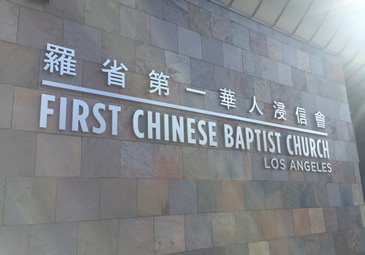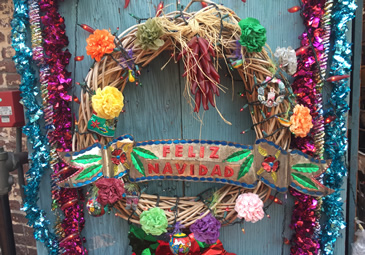
First Chinese Baptist Church
From humble beginnings in an abandoned noodle factory, the church now owns multiple properties on Yale Street to host services and religious education.
Despite coming from two very different cultural origins, Chinatown and Olvera Street alike have strong Christian influences that dominate both communities.

From humble beginnings in an abandoned noodle factory, the church now owns multiple properties on Yale Street to host services and religious education.

The community founded in 1952 hosts a variety of members in its congregation, for native Angelinos to immigrants from China, Hong Kong, and Vietnam.

As the primary room for Sunday services, the First Chinese Baptist Church Sanctuary can hold the large community it has fostered in Chinatown and beyond.

Once just a humble chapel created by Spanish settlers, Our Lady Queen of Angels parish receives thousands of visitors a year who come to pay homage to the Virgin Mary.

Religious imfluences are particularly visible in the merchandise sold at many of Olvera Street's stalls, from holiday wreaths like this one to photos of the Virgin Mary.
Before taking their lunch break, Denise Wong and Sharon Lim sat down at the table and prayed a blessing. They thanked God for the food they were about to eat and thanked him for giving them another day on earth.
Both women work at the First Chinese Baptist Church in Chinatown, Wong as a receptionist, Lim as a business consultant. They have been a part of the community for decades, Lim even watched the church grow with her over the past fifty years, and raised their kids in the Christian environment they themselves grew up in. Christian influence in this northeast corridor of downtown Los Angeles has shaped the neighborhoods that it fosters, offering a family-oriented environment for native Angelinos and immigrants alike.
“Our church really is three congregations: English, Cantonese, and Mandarin,” Lim said. “Because the needs are different for each of the groups we have different events to provide for each group.”
Emory Chow, a Southern Baptist Missionary that wanted to reach out to the Chinese community in downtown, founded FCBC in 1952. Starting with a humble first service in an abandoned noodle factory, the church has expanded to accommodate a huge congregation in multiple buildings on Yale Street.
The Chinatown neighborhood is a particularly important area for a community like this to exist because it stands at the initial stopping point for immigrants from China and Vietnam before they settle further inland. Some families still commute to Sunday services at First Chinese Baptist after moving east.
“Most of our church members are commuters, and they come from the San Gabriel valley. Because Chinatown is a starting point for so many, they tend to come back, and we now have a very large community because of it,” Lim said.
Meanwhile, a couple blocks over, the Latino community finds similar unity through their Christian faith. Olvera Street, known for housing the oldest settlement in California, hosts events throughout the year on Holy Days of Obligation, Catholic holidays commemorating important Biblical and religious figures and events.
Over the period of Advent, the four weeks of preparation leading up to Christmas, the community will celebrate “Dia de la Virgen de Guadaloupe” and “Las Posadas.”
The former event acknowledges the Virgin Mary’s birthday through a day of music, prayer, and almsgiving. On Olvera Street, up to 200,000 people will congregate on the evening of December 11 and 12 to honor the Bless Virgin and ask for her assistance. “Las Bandas” fill the square to play music throughout the night, and devout believers can be seen crawling on their knees to lay flowers at the Virgen de Guadaloupe mural at La Placita, the oldest church in California.
Richard Hernandez, owner of the Olvera Street donkey, has worked on the street for decades. In this clip, he got emotional describing the scene during this holy time.
The following week, Las Posadas commemorates the birth of Jesus in Bethlehem by reenacting the procession to the manger. Children in the community lead a candlelight procession dressed as shepherds, wise men, angels, and Mary and Joseph. English and Spanish songs are sung throughout the walk down Olvera Street, occasionally making stops at stalls to symbolize the many inns Mary and Joseph stopped at. When they are eventually invited in, the community joins together in celebration, bursting piñatas and indulging in champurrado and pan dulce.
The gazebo at the center of the main square houses a Nativity Scene during the holiday season, and tourists and natives alike stop to take in the beautiful scene. Some kneel down and pray, while others simply snap a photo and move on.
For stall owners and visitors alike, the sense of community runs strong on Olvera Street during religious festivities because religion is a daily influence there. The street stands opposite La Pacita, a Catholic hearth in Los Angeles. The visage of Mary is seen consistently from stall to stall, even the occasional mini-Nativity during the holidays. The quaint tourist attraction relies on its religious influences, crediting a strong Catholic influence for crowds of 200,000 walking down its street.
Both the Chinatown and Olvera Street Christian communities emphasize a unity in faith. People from all walks of life come for big celebrations, or simply a Sunday service. Though these largely immigrant communities are fairly different, their differences converge in their faith and help them to find a sense of purpose and belonging in the Los Angeles community.
“Our kids have a pretty solid foundation in knowing who Christ is and have a good moral background because of it. They know who they are, they know why they’re here on earth,” Wong said. “For example, my son is going to be a missionary in West Africa, my daughter works with Johnny Erickson, so they try to find jobs with purpose so they have meaning for their lives and not just a nine-to-five.”